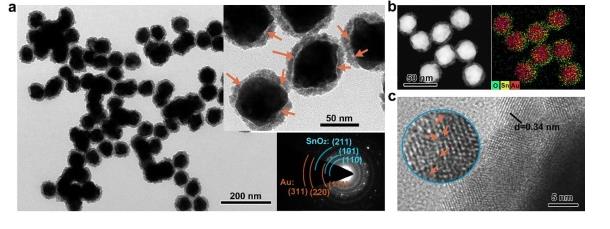Your current location:
- Home>
- Achievements>
- Research Papers
Defective-tin-oxide wrapped gold nanoparticles with strong sunlight harvesting and efficient charge separation for photocatalysis
Author: Bao Haoming£»Zhou Le£»Liu Dilong£»Zhang Hongwen£»Zhu Shuyi£»Fu Hao£»Cai Weiping
Periodical: CHEMICAL ENGINEERING JOURNAL
Page: ¾í420 ×Ó¼1
Full text link: https://www.sciencedirect.com/science/article/pii/S1385894721015655?via%3Dihub

Periodical: CHEMICAL ENGINEERING JOURNAL
Page: ¾í420 ×Ó¼1
Full text link: https://www.sciencedirect.com/science/article/pii/S1385894721015655?via%3Dihub

Strong sunlight harvesting and efficient charge separation are of great significances for solar energy utilization of metal oxides, but it is a challenge to realize these two aspects simultaneously. Here, we strategize oxygenvacancy-rich (or defective)-SnO2 wrapped gold nanoparticles (Au@D-SnO2 NPs) for this. The designed NPs are fabricated just by adding precursors into boiling pre-prepared Au colloidal solution and then re-dispersing the reacted NPs in water, based on surface alloying and selective oxidation. Typically, the fabricated Au@D-SnO2 NPs (with 12 nm thick shell) exhibit strong absorption in full solar spectrum (200-2000 nm) with an energy absorption efficiency as high as 84%. Meanwhile, the photocurrent response of the typical NPs is 2.3 and 13.6 times as high as that of Au@SnO2 NPs (with poor oxygen vacancies) and commercial SnO2 NPs, respectively, showing efficient charge separation. Such excellent performance is attributed to the synergistic effect of surface plasmon resonance (SPR) of the Au core and the band gap narrowing induced by the abundant oxygen vacancies. Further, the excellent photocatalytic performance of the Au@D-SnO2 NP catalyst has been demonstrated via exemplary photocatalytic removal of gaseous ammonia. The catalytic rate is about 4.2 and 25 times as high as that of the Au@SnO2 NP and the commercial SnO2 NP catalysts, respectively. It is expected that such excellent photocatalytic performance will also be obtained on other defective oxides wrapped metal structures. This work provides a preparation method for Au@D-SnO2 NPs, which can be used for efficient solar energy utilization.
